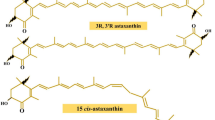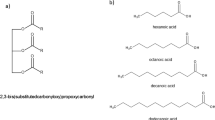Abstract
To obtain valuable information for development of potential commercial products from yak kidney, which is usually treated as waste, the fatty acid composition of kidneys from yak reared in Gansu province, China, was investigated by gas chromatography. Fifteen different fatty acids were identified. The major fatty acids are oleic acid (33.3%), stearic acid (20.2%), and palmitic acid (18.4%). More interestingly, several important and essential fatty acids were also identified, including conjugated linoleic acid (2.94%), omega-3 fatty acids, for example docosahexaenoic acid (1.47%), eicosapentaenoic acid (1.11%) and alpha linolenic acid (0.37%), and omega-6 fatty acids, for example arachidonic acid (2.86%) and linoleic acid (1.98%). The results show that the fatty acid composition of yak kidney is of reasonable value and is suitable for further development of possible commercial products. This is the first report of the fatty acid profile of yak kidney.

Similar content being viewed by others
References
Spiller GA (2006) In: Spiller GA (ed) Handbook of lipids in human nutrition. CRC Press, Boca Raton
Wainwright PE (1992) Neurosci Biobehav Rev 16:193–205. doi:10.1016/S0149-7634(05)80180-0
Kruger MC, Horrobin DF (1997) Prog Lipid Res 36:131–151. doi:10.1016/S0163-7827(97)00007-6
Friedman AN, Moe SM, Perkins SM, Li Y, Watkins BA (2006) Am J Kidney Dis 47:1064–1071. doi:10.1053/j.ajkd.2006.03.033
Demirbas A (2007) Prog Energy Combust Sci 33:1–18. doi:10.1016/j.pecs.2006.06.001
Bouaid A, Martinez M, Aracil J (2007) Chem Eng J 134:93–99. doi:10.1016/j.cej.2007.03.077
Trakarnpruk W, Porntangjitlikit S (2008) Renew Energy 33:1558–1563. doi:10.1016/j.renene.2007.08.003
Morgavi DP, Boudra H, Jouany JP, Michalet-Doreau B (2004) Food Addit Contam 21:871–878. doi:10.1080/02652030400002188
Jandacek RJ (1991) Lipids 26:250–253. doi:10.1007/BF02543981
Banskalieva VV, Sahlu T, Goetsch AL (2000) Small Rumin Res 37:255–268. doi:10.1016/S0921-4488(00)00128-0
Christie WW (1993) In: Christie WW (ed) Advances in lipid methodology—two. Oily Press, Dundee
Sun J, Chen GC, Zhao XN (2007) Chromatographia 65:469–476. doi:10.1365/s10337-007-0171-4
Jesuı VV, Maximiliano DN (2007) J Am Oil Chem Soc 84:543–547. doi:10.1007/s11746-007-1070-4
Savage GP, Dutta PC, McNeil DL (1999) J Am Oil Chem Soc 76:1059–1063
Antolin EM, Delange DM, Canavaciolo VG (2008) J Pharm Biomed Anal 46:194–199. doi:10.1016/j.jpba.2007.09.015
Tan L, Zhao XP, Liu XQ (2005) Chromatographia 62:305–309. doi:10.1365/s10337-005-0604-x
Kramer JK, Hernandez M, Cruz-Hernandez C, Kraft J, Dugan ME (2008) Lipids 43:259–273. doi:10.1007/s11745-007-3143-4
Donmez M, Seckin AK, Sagdc O, Simsek B (2005) Int J Food Sci Nutr 56:157–163. doi:10.1080/09637480500131137
Or-Rashid MM, Odongo NE, McBride BW (2007) J Anim Sci 85:1228–1234. doi:10.2527/jas.2006-385
Bligh EG, Dyer WJ (1959) Can J Biochem Physiol 37:911–917
Winter R (1994) In: Winter R (ed) A consumer’s dictionary of food additives. Crown Trade Paperbacks, New York
Sinclair HM (1961) Proc Nutr Soc 20:149–156. doi:10.1079/PNS19610039
Wenk C (2004) Physiol Behav 83:565–571. doi:10.1016/j.physbeh.2004.07.025
Fernández-Quintela A, Churruca I, Portillo MP (2007) Public Health Nutr 10:1126–1131. doi:10.1017/S1368980007000602
Kelley DS (2001) Nutrition 17:669–673. doi:10.1016/S0899-9007(01)00576-7
Adahchour M, Beens J, Brinkman UA (2008) J Chromatogr A 1186:67–108. doi:10.1016/j.chroma.2008.01.002
Acknowledgments
We gratefully acknowledge the assistance of Ting-peng Huang, Zi-rong Zhao, Gang Ma, and Xia Zhu in GC analysis.
Author information
Authors and Affiliations
Corresponding authors
Additional information
An erratum to this article is available at http://dx.doi.org/10.1365/s10337-009-1035-x.
Rights and permissions
About this article
Cite this article
Wang, Q., Wu, J., Zhang, S. et al. GC Analysis of the Fatty Acid Composition of Yak Kidney. Chroma 69, 139–143 (2009). https://doi.org/10.1365/s10337-008-0845-6
Received:
Revised:
Accepted:
Published:
Issue Date:
DOI: https://doi.org/10.1365/s10337-008-0845-6




